To darn pointe shoes, start by gathering a needle, thread, and a pair of scissors. Then, carefully sew through the worn-out areas of the shoe, using a tight and even stitch.
Finally, trim the excess thread and repeat the process as needed. Darning pointe shoes involves sewing through the worn-out areas to reinforce and extend the life of the shoes. By following these steps, you can effectively darn your pointe shoes and continue to dance safely and comfortably.
Dancers who practice ballet and wear pointe shoes are well aware of the challenges involved in maintaining their footwear. Over time, the friction and pressure exerted on the shoes during intense training sessions can lead to wear and tear. However, with the proper technique and some sewing skills, you can learn how to darn pointe shoes. Darning the shoes involves reinforcing the damaged areas by sewing them back together. This process extends the lifespan of the shoes, providing dancers with more time to perfect their routines without worrying about the shoes deteriorating prematurely. In the following paragraphs, we will guide you through the steps required to effectively darn your pointe shoes, ensuring you can continue dancing with confidence and comfort
Introduction To Pointe Shoes
Pointe shoes are an essential part of a ballet dancer’s equipment, enabling them to perform intricate footwork and dance en pointe. These specialized shoes are designed to provide support and stability to the dancer while executing various movements on their toes.
In this section, we will explore the different types of pointe shoes used in ballet and the importance of maintaining and repairing them.
Different Types Of Pointe Shoes Used In Ballet:
- Traditional pointe shoes: These are the classic satin shoes that are commonly used in ballet. They have a hardened toe box, which helps to support the dancer’s toes and distribute the body weight evenly.
- Split sole pointe shoes: Unlike traditional pointe shoes, split sole shoes have a sole that is divided into two parts, allowing for greater flexibility of the foot. This design is preferred by some dancers who value a deeper arch and greater articulation in their movements.
- Soft block pointe shoes: These shoes have a soft toe box, which provides a more cushioned feel for the dancer. They are often favored by dancers who have sensitive feet or prefer a more comfortable fit.
- Custom-made pointe shoes: Some dancers choose to have their pointe shoes custom-made to fit their unique foot shape and structure. This ensures a perfect fit and can enhance the dancer’s performance and comfort.
Importance Of Maintaining And Repairing Pointe Shoes:
- Ensures longevity: Proper maintenance and repair of pointe shoes can extend their lifespan, saving dancers from frequently purchasing new pairs.
- Safety and support: Maintaining and repairing pointe shoes helps to ensure that they remain in optimal condition, providing the necessary support and stability to the dancer’s feet.
- Prevents injury: Well-maintained pointe shoes reduce the risk of discomfort, blisters, and foot injuries during demanding ballet routines.
- Enhances performance: By keeping pointe shoes in good condition, dancers can perform at their best, with improved control and precision in their movements.
- Cost-effective: Repairing minor damages or wear and tear on pointe shoes is typically more affordable than buying new ones. This can be especially beneficial for dancers who are on a tight budget.
- Personalized fit: Regular maintenance allows dancers to customize the fit of their pointe shoes through techniques like darning, padding, and adjusting the shoe shape to accommodate their specific foot needs.
Taking proper care of pointe shoes is crucial for dancers aiming to excel in ballet. Regular maintenance not only ensures their longevity but also allows dancers to perform safely and comfortably, maximizing their potential on stage. Through techniques like darning and individualized customization, dancers can keep their pointe shoes in optimal condition, showcasing their skills with poise and grace.
Understanding Darning
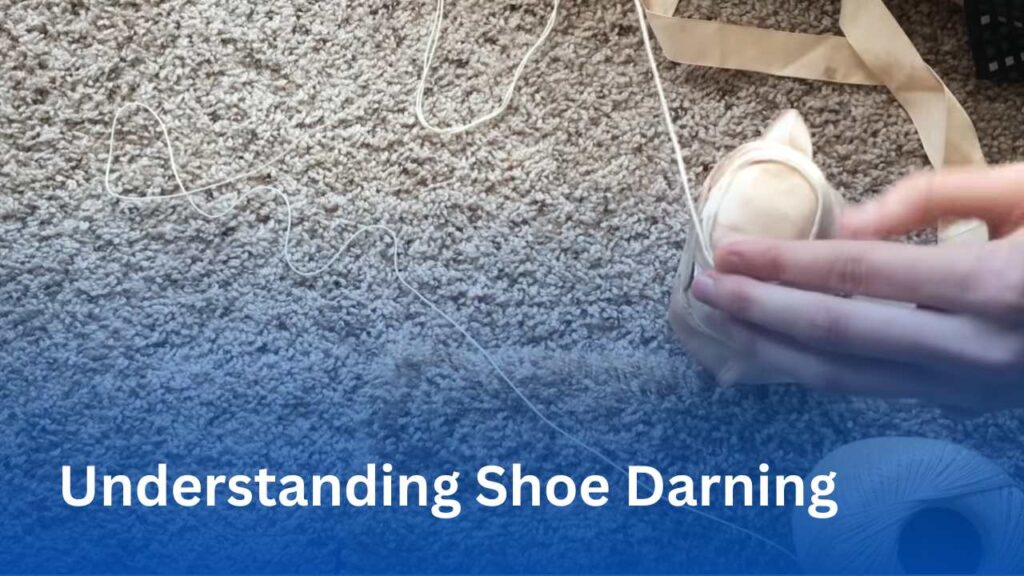
What Is Darning And Why It Is Necessary For Pointe Shoes
Darning is an essential technique used to repair and reinforce pointe shoes. Pointe shoes undergo tremendous wear and tear due to the rigorous demands of ballet. As dancers constantly work on their toes, the delicate satin fabric of the pointe shoe can become worn out and prone to holes.
Darning involves stitching layers of thread over weakened areas, providing reinforcement and prolonging the lifespan of the shoe.
Here are some key points to understand about darning:
- Darning strengthens weakened areas: By applying layers of thread over worn-out spots, darning provides added strength to the fabric and allows dancers to keep using their pointe shoes for longer.
- The process requires precision: Darning should be done with care and attention to detail to ensure the durability of the shoe. It may take some practice to achieve the desired results.
- Darned shoes maintain their structure: Darning helps to preserve the structural integrity of pointe shoes. By reinforcing vital areas, such as the platform and heel, dancers can continue to perform with confidence.
- It provides customized support: Darning can be tailored to a dancer’s specific needs and preferences. By strategically placing reinforcing stitches, dancers can achieve a personalized level of support and comfort.
- Regular maintenance is essential: Dancers should regularly inspect their pointe shoes for signs of wear and tear. It is recommended to start darning as soon as the shoes show signs of weakness, rather than waiting for holes to appear.
Understanding darning is crucial for dancers who rely on pointe shoes to perform at their best. By mastering this technique, dancers can extend the life of their pointe shoes and continue pursuing their passion with confidence.
Materials Needed for Darn Pointe Shoes
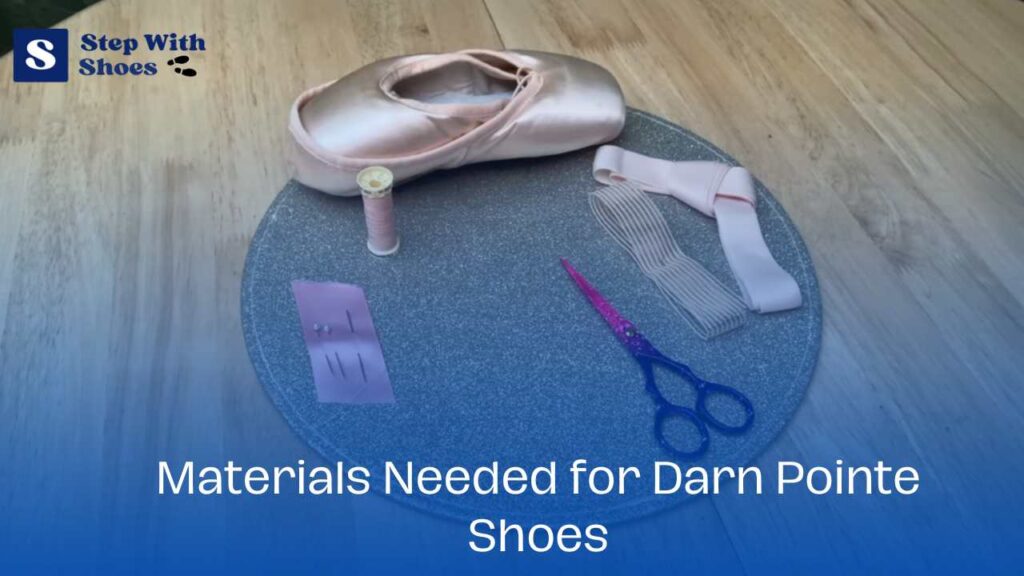
List Of Materials Required For Darning Pointe Shoes
Darning pointe shoes is an essential skill for any ballet dancer. It can prolong the lifespan of the shoes and provide added support. To get started, you’ll need a few materials. Here’s a list of what you’ll need:
- Needle: Choose a needle specifically designed for darning. It should be thin and sharp, allowing you to easily penetrate the pointe shoe fabric.
- Thread: Opt for a strong and durable thread, such as polyester or nylon. The color of the thread should be similar to the color of your pointe shoes for a seamless repair.
- Scissors: Make sure to have a pair of small, sharp scissors to trim the thread and any excess fabric.
- Thimble: A thimble is crucial to protect your finger while pushing the needle through the tough pointe shoe material.
- Seam ripper: This handy tool will help you remove any damaged satin or stitching from the shoe before starting the darning process.
- Chalk or fabric marker: These are useful for marking the area on the shoe that needs to be darned, ensuring accuracy in your repair.
Now that you have all the necessary materials, you’re ready to embark on your darning journey!
Importance Of Choosing The Right Materials For Darning
When it comes to darning pointe shoes, using the right materials is crucial. The quality of the materials directly affects the durability and effectiveness of the repair. Here’s why it’s important to choose the right materials:
- Durability: Pointe shoes endure a lot of stress and strain during performances and rehearsals. Using strong thread and high-quality needles ensures that the darned area can withstand the demands of dancing.
- Support: Darning provides extra support to the weakened areas of the pointe shoe. Opting for sturdy materials helps maintain the shoe’s structure, preventing premature wear and tear.
- Aesthetics: Selecting thread that matches the color of your pointe shoes will help create a neat and seamless repair. The right materials will blend seamlessly into the shoe, making it difficult to spot the darned area.
- Longevity: Well-darned pointe shoes can last longer, saving you money in the long run. By using the appropriate materials, you can ensure that your repairs stand the test of time and extend the lifespan of your beloved pointe shoes.
By investing in the right materials for darning, you’ll be able to maintain the quality and integrity of your pointe shoes for many performances to come. So gather your supplies and get ready to tackle this essential skill!
Preparing The Pointe Shoes
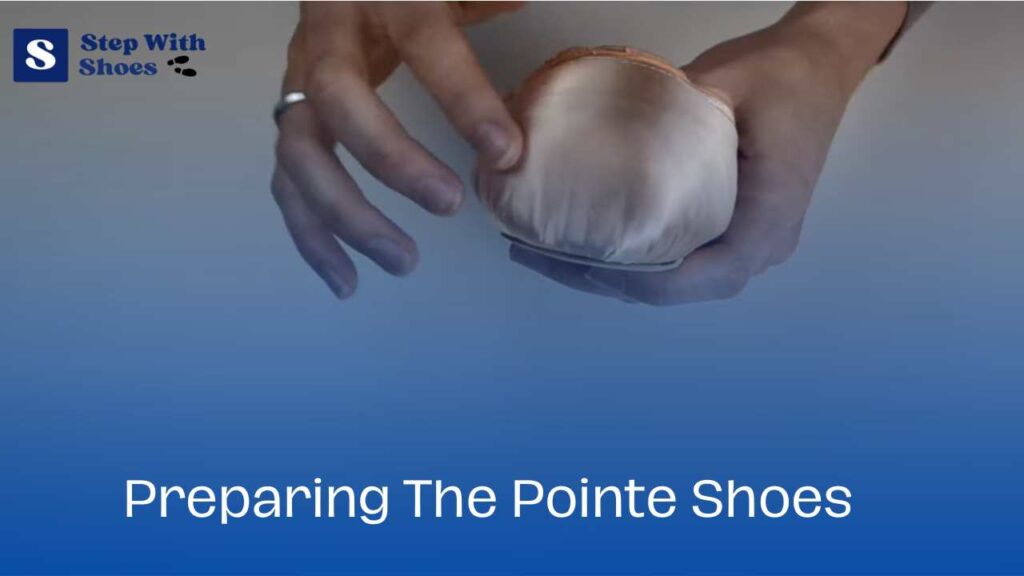
Cleaning And Drying The Pointe Shoes Before Darning
Before you start darning your pointe shoes, it’s important to prepare them properly. This involves cleaning and drying them to ensure the best results. Here are the key steps to follow:
- Remove any excess dirt or dust from the pointe shoes using a soft brush or cloth.
- Mix a small amount of mild detergent with warm water in a bowl.
- Dip a clean cloth or sponge into the soapy water and gently wipe down the exterior of the pointe shoes.
- Pay extra attention to areas that tend to accumulate dirt or sweat, such as the toe box and shank.
- Rinse the pointe shoes with clean water to remove any soap residue.
- Use a towel to absorb excess water from the pointe shoes, being careful not to deform their shape.
- Allow the pointe shoes to air dry completely in a well-ventilated area. Avoid exposing them to direct sunlight or heat, as this can cause damage.
Remember, proper cleaning and drying of your pointe shoes is essential to ensure a clean and suitable surface for darning. By following these steps, you’ll be ready to assess the areas that need darning and proceed with confidence.
Choosing The Right Thread
Importance Of Using The Correct Thread For Darning
Darning pointe shoes is a crucial skill for any ballet dancer. It not only prolongs the shoes’ lifespan but also ensures optimal support and stability during performances. One key element in darning pointe shoes is choosing the right thread.
Here, we discuss the importance and factors to consider when selecting the perfect thread for darning.
Factors To Consider When Selecting Thread For Darning
When it comes to darning pointe shoes, the type of thread you choose plays a significant role in the overall durability and effectiveness of the repair. Here are some key factors to consider when selecting the ideal thread:
- Thread color: Opt for a thread color that closely matches the color of your pointe shoes. This way, the darned area will blend seamlessly with the rest of the shoe, giving it a neater appearance.
- Thread strength: Ensure that the thread you choose is strong and durable. Pointe shoes endure rigorous movement and stress, so using a sturdy thread will help prolong the lifespan of your shoes and prevent premature wear and tear.
- Thread thickness: Select a thread thickness that matches the original stitching of your pointe shoes. Using a thicker or thinner thread than the original stitches can compromise the shoe’s structure and affect its fit.
- Material compatibility: Consider the material of your pointe shoes when choosing the thread. Different fabrics may require different types of thread, such as silk or polyester. Make sure the thread is compatible with the material of your shoes for optimal results.
- Needle compatibility: Ensure that the thread you choose can easily pass through the eye of the needle without fraying or breaking. Using a needle and thread that work well together will make the darning process much easier and more efficient.
- Brand recommendations: Seek advice from experts or fellow dancers on reputable brands and types of thread that work best for darning pointe shoes. Many experienced dancers have their preferred brands and can provide valuable insights based on their own experiences.
- Availability and cost: Lastly, consider the availability and cost of the thread. You want to choose a thread that is readily accessible and fits within your budget. However, make sure to prioritize quality and durability over cost when making your selection.
By considering these factors, you can choose the right thread for darning your pointe shoes and ensure a long-lasting and effective repair. Remember, investing time and effort into maintaining your pointe shoes will enhance your performance and help you dance with confidence and grace.
Darning Techniques
Darning pointe shoes is an essential skill for every dancer. Whether you’re a professional ballerina or a dedicated student, knowing how to properly darn your pointe shoes can extend their lifespan and improve their performance. In this section, we will explore the basic steps involved in darning pointe shoes and different darning techniques for various areas of the shoe.
Basic Steps Involved In Darning Pointe Shoes
Darning pointe shoes may seem daunting at first, but with practice and patience, you’ll become proficient in this essential skill. Here are the basic steps involved in darning pointe shoes:
- Prepare the shoe: Remove any old darns or stitches and clean the area where the new darning will be applied. Ensure that the shoe is dry and free from any dirt or debris.
- Thread the needle: Choose a strong and durable thread that matches the color of your shoe. Double or triple thread the needle to ensure it is secure and won’t easily break.
- Secure the starting point: Start by creating a small knot at the inside of the shoe on the area you want to darn. This will provide a secure anchor for your stitches.
- Create a foundation grid: Begin by creating a grid of stitches across the area you want to darn. This will provide a solid base for the subsequent stitches and prevent them from pulling through the fabric.
- Make evenly spaced stitches: Using small and even stitches, create a dense pattern across the darning area. Ensure that each stitch is tight and secure, but not so tight that it distorts the shape of the shoe.
- Build up the layers: Continue adding layers of stitches, gradually filling in the space and reinforcing the darning area. This will provide extra strength and durability to the shoe, allowing it to withstand the strain of dancing on pointe.
- Finish the darning: Once you have achieved the desired level of reinforcement, securely knot the thread on the inside of the shoe. Trim any excess thread to ensure a neat and tidy finish.
Different Darning Techniques For Various Areas Of The Shoe
Not all areas of a pointe shoe experience the same amount of wear and tear. To create a well-balanced and durable shoe, different darning techniques are employed for various areas. Here are some common darning techniques used for different parts of the shoe:
- Toe area: The toe area of a pointe shoe is subjected to significant pressure, so it requires extra reinforcement. Darn the toe area using tight and dense stitches, concentrating on the stitch pattern near the platform of the shoe.
- Shank area: The shank area provides crucial support for the dancer’s arches. Darn this area in a way that adds strength and stability to the shoe. Use a combination of densely packed stitches and overlapping layers to reinforce the shank.
- Side seams: The side seams of a pointe shoe can be prone to fraying and splitting. Darn along the side seams using strong and secure stitches to prevent the fabric from unraveling and maintain the integrity of the shoe.
- Heel area: The heel area of a pointe shoe experiences constant friction and pressure. Darn the heel area using a combination of tight stitches and reinforcing layers to ensure durability and prevent premature wear.
Remember, the key to successful darning is practice and attention to detail. Take your time, experiment with different techniques, and find what works best for you and your shoes. With proper darning, you can prolong the lifespan of your pointe shoes and dance with confidence.
Step-By-Step Darning Process
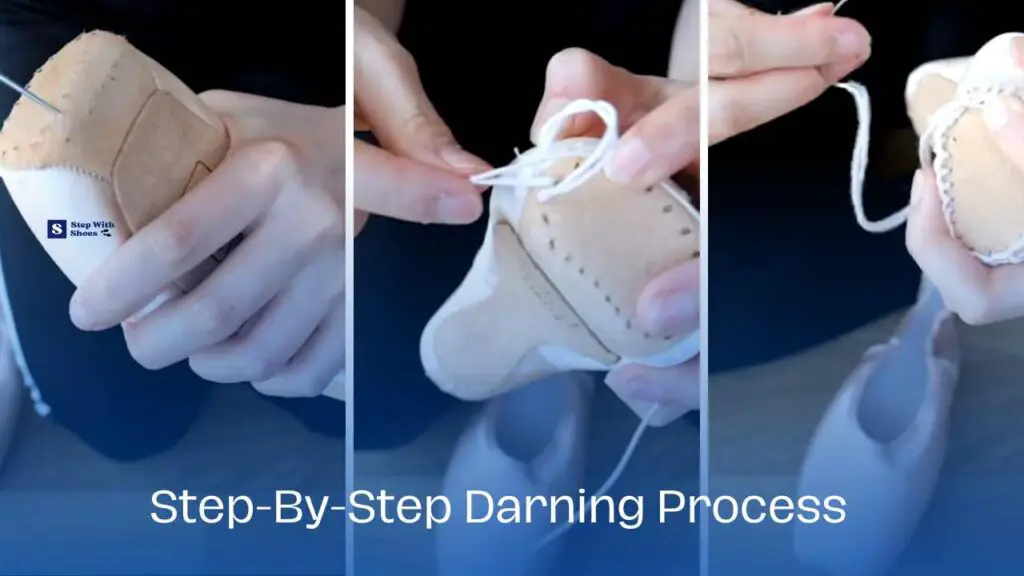
Detailed Instructions For Darning The Toe Area Of The Pointe Shoe
Darning the toe area of pointe shoes is an essential skill that every ballet dancer should have. It helps to extend the lifespan of the shoe and provides added support to the dancer’s feet. Here is a step-by-step guide on how to darn the toe area of your pointe shoes.
- Start with a clean and dry pointe shoe to ensure optimal adhesion of the darning thread.
- Thread a needle with sturdy darning thread that matches the color of your pointe shoe or is slightly darker for added visibility.
- Begin by making small anchoring stitches on the side of the toe box, near the platform. These stitches will secure the initial strands of darning thread.
- Create a figure-eight pattern with your darning thread across the toe area. Start by stitching from the left side of the toe box to the right, creating small “x” shapes. Repeat this process, stitching from right to left, until the toe area is covered in a grid-like pattern.
- Continue to stitch additional layers of darning thread, gradually building up the toe area to provide extra support. Make sure to alternate the direction of your stitches to ensure even coverage and prevent weak spots.
- As you stitch, ensure that the tension of the darning thread is firm but not too tight. This will create a sturdy and flexible toe box.
- Pay close attention to any areas of the toe box that may be experiencing excessive wear or fraying. Add extra stitching or reinforcing stitches to these areas to prolong the life of your pointe shoe.
Darning Techniques For The Shank And Other Areas
In addition to darning the toe area, it is important to reinforce other vulnerable areas of the pointe shoe, such as the shank. Here are some key techniques to consider:
- Shank darning: To strengthen the shank of your pointe shoe, stitch the darning thread in a crisscross pattern along the length of the shank. This will provide added support and prevent the shank from breaking prematurely.
- Side seams: Reinforce the side seams of your pointe shoe by stitching along the edges of the satin fabric. This will help prevent the seams from unraveling and ensure the shoe maintains its shape.
- Heel area: Darn the heel area of your pointe shoe by stitching additional layers of darning thread where the fabric is prone to wearing down. This will extend the life of your shoe and provide extra support for your feet.
- Elastic attachments: Secure the elastic attachments of your pointe shoe by stitching them firmly to the shoe. This will prevent the elastics from coming loose during dance movements.
Remember, darning is a skill that improves with practice. Take your time and experiment with different techniques to find what works best for you. By properly darning your pointe shoes, you can ensure they withstand the demands of ballet and provide the necessary support for your feet.
Maintaining Darned Pointe Shoes
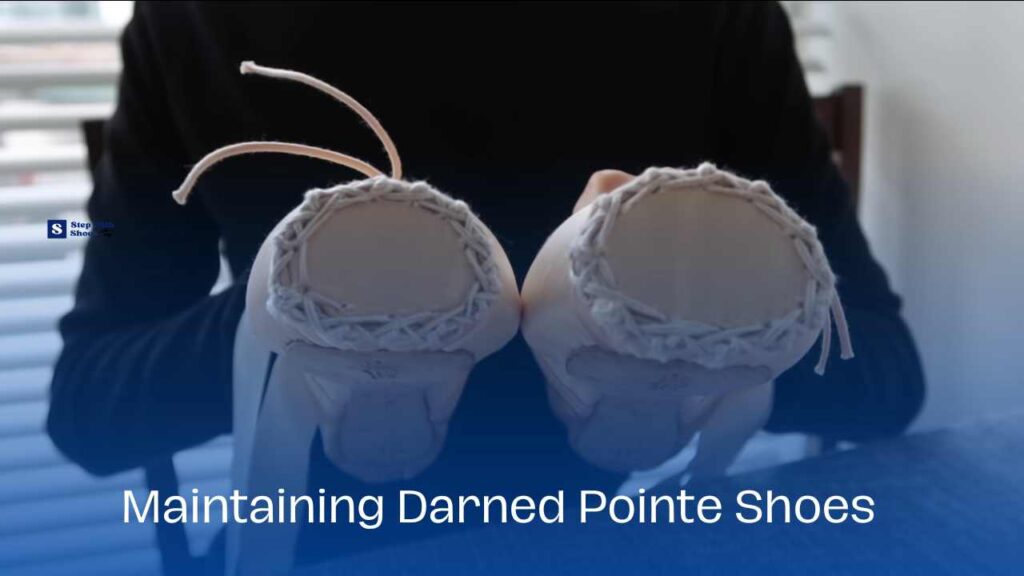
Care Tips For Preserving The Durability Of Darned Shoes
Darning pointe shoes in itself is an art. It requires skill, patience, and precision. Once your pointe shoes have been darned, it’s important to take proper care of them to extend their lifespan and maintain their functionality. Here are some tips on how to preserve the durability of darned pointe shoes:
Store Them Properly:
- Keep your darned pointe shoes in a breathable bag or pouch to prevent them from getting crushed or damaged.
- Avoid storing them in plastic bags as they can trap moisture, leading to unpleasant odors and deterioration.
- Find a dedicated space to store your pointe shoes, away from excessive heat, direct sunlight, and damp areas.
- Never store your pointe shoes in a wet or damp state, as it can weaken the materials and shorten their lifespan.
Transport With Care:
- When traveling to dance classes or performances, use a shoe bag specifically designed for pointe shoes.
- Ensure that your bag provides enough protection to prevent your shoes from being squished or jostled.
- Avoid placing heavy objects on top of your pointe shoes to prevent them from getting deformed.
- When packing your dance bag, make sure to place your pointe shoes in a separate compartment away from sharp objects or potential sources of damage.
Take Care Of The Ribbons And Elastics:
- Regularly inspect the ribbons and elastics, checking for signs of wear and tear.
- Replace any worn-out or frayed ribbons and elastics promptly to avoid accidents and ensure proper support.
- Avoid pulling or tugging on the ribbons and elastics excessively as it can damage the stitching and weaken the attachment to the shoes.
- When not in use, fold the ribbons and elastics neatly and secure them with a soft band or clip to prevent tangling.
Keep Them Clean:
- Clean your pointe shoes regularly to remove sweat, dirt, and oils that can accumulate on the surface.
- Use a soft cloth or brush to gently wipe away any residue from the satin or leather parts of the shoes.
- Avoid using harsh chemicals or abrasive materials that can damage the delicate materials of your pointe shoes.
- Allow your pointe shoes to air dry completely before storing them to prevent the growth of mold or bacteria.
Rotate Between Pairs:
- If you have multiple pairs of pointe shoes, rotate between them to allow for proper drying and recovery after each use.
- Alternating between pairs can help extend their lifespan and maintain their shape and support.
- Avoid wearing the same pair of pointe shoes for consecutive classes or performances to prevent excessive wear and tear.
By following these care tips, you can ensure that your darned pointe shoes remain in good condition for longer. Properly storing, transporting, and maintaining them will not only help with their durability but also provide you with the necessary support and comfort while dancing.
So, take care of your pointe shoes like the valuable assets they are!
Remember, maintaining your pointe shoes is just as important as donning them. Take the time to care for your dancewear, and it will repay you with many graceful performances.
Extending the Life of Pointe Shoes
Preventing Future Damage
Preventing damage to your pointe shoes is crucial for their longevity. Consider the following tips:
- Maintain Proper Technique: Ensure you dance with the correct technique to reduce wear and tear.
- Use Floor Protection: Invest in floor mats or dance pads to minimize friction between the shoes and the floor.
- Monitor Foot Hygiene: Avoid dancing with excessive sweating or injuries that can accelerate damage.
- Inspect Shoes Regularly: Check for loose threads and potential issues, and address them promptly.
These proactive measures can help extend the life of your pointe shoes.
Proper Storage Techniques
Proper storage is key to preserving your pointe shoes. Follow these practices:
- Allow Shoes to Air Out: Remove them from your bag after practice to reduce moisture buildup.
- Choose Breathable Storage: Use a mesh or fabric bag for storage to allow air circulation.
- Avoid Plastic Bags: Don’t seal your shoes in plastic bags as they can trap moisture.
- Use Absorbent Inserts: Place baking soda or cedar shoe inserts in the bag to absorb moisture and odors.
By storing your pointe shoes correctly, you can keep them in good condition between uses.
Frequency of Darning and Retiring Pointe Shoes
Knowing when to darn and retire pointe shoes is essential. Consider the following guidelines:
- Darning Frequency: Darn your shoes as soon as you notice significant damage, such as holes or fraying.
- Dance Intensity: The frequency of dancing may vary based on your dance intensity.
- Shank Condition: If the shank becomes too soft and loses support, it’s time to replace the shoes.
- Comfort and Fit: If the shoes no longer fit well or cause discomfort, consider retiring them.
Retiring pointe shoes is a natural part of a dancer’s journey. Be attentive to wear and consult with professionals when needed to ensure your safety and continued progress.
When To Redarn Pointe Shoes
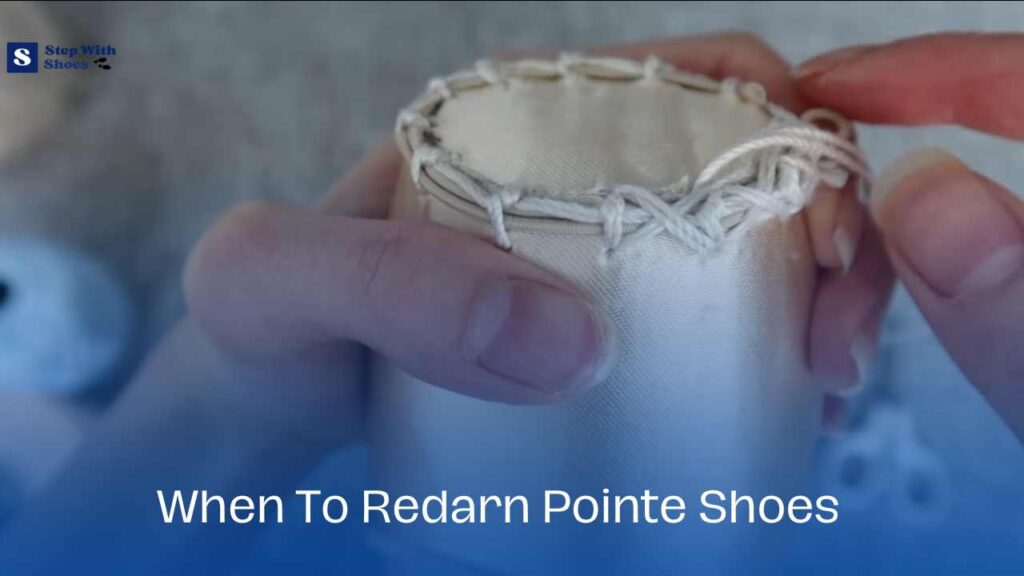
Signs That Indicate It’S Time To Redarn Pointe Shoes:
- Visible wear and tear: If you start noticing frayed threads, holes, or thinning fabric on the toes or any other areas of the pointe shoes, it’s a clear indication that the drawing needs to be redone.
- Breakdown of darning stitches: Over time, the stitches used to darn the shoes can start to come undone or loosen, diminishing their effectiveness in providing support and stability. If you find loose or broken stitches, it’s time to return the shoes.
- Decreased durability: Pointe shoes that have become less durable and are starting to wear out more quickly may benefit from being returned. If you notice that your shoes are not holding up as well as they used to, it’s a sign that they need to be re-darned.
Steps for removing old darning and beginning the process again:
- Carefully remove the old darning: Begin by using a pair of sharp scissors to cut away the old stitches and carefully remove the darning thread. Take your time and be gentle to avoid damaging the shoe or the surrounding material.
- Clean the area: Once the old darning is removed, make sure to clean the area thoroughly. Use a small brush or cloth to remove any remaining loose threads or debris. This will ensure a clean surface for the new darning.
- Prepare the new darning thread: Select a strong and durable darning thread that matches the color of your pointe shoes. Cut a long piece of thread, approximately double the length of the area you will be darning, to have enough for the process.
- Start darning: Begin by anchoring the thread securely to the shoe, either by tying a knot or making a few small stitches. Then, using a needle, start weaving the thread in and out of the fabric to create a series of diagonal stitches. Make sure to pull the thread tight after each stitch to create firm and supportive darning.
- Continue darning the area: Work your way across the area that needs darning, using a consistent and even pattern. Make sure to cover the entire area with stitches, ensuring a strong and reinforced finish. Keep the tension of the stitches firm but not too tight, allowing the shoe to maintain its flexibility.
- Secure the end: Once you reach the end of the area, secure the thread by either tying a knot or making a few small stitches. Trim any excess thread carefully to ensure a neat finish.
Remember, regular maintenance of your pointe shoes, including when needed, will help prolong their lifespan and keep them in optimal condition for dancing. By paying attention to the signs that indicate it’s time to learn, and following the steps to remove old darning and begin the process again, you can ensure that your pointe shoes provide the necessary support and comfort for your performances.
When to Seek Professional Help for Darn Pointe Shoes
Situations Requiring Professional Darning
While many dancers can darn their pointe shoes themselves, there are specific situations where professional help is not just beneficial but necessary. Here are some scenarios when you should consider having a professional cobbler or pointe shoe fitter handle the darning:
1. Complex Darns: If the damage to your pointe shoes is extensive or located in a challenging area, such as the shank or platform, it’s best to seek professional assistance. Cobbler experts have the experience and equipment needed to execute intricate repairs effectively.
2. Lack of Experience: If you are new to darning pointe shoes or lack confidence in your darning skills, it’s wise to consult a professional. They can ensure that the repair is done correctly, preventing any mishaps that might compromise the shoe’s performance.
3. Precise Stitching: Achieving the correct tension and stitch placement is crucial for the shoe’s support and durability. Professionals can provide the level of precision required to maintain the shoe’s integrity.
4. Preserving Custom Features: Some pointe shoes come with custom features, like unique stitching patterns or personalized modifications. Professionals can maintain these features while darning, ensuring the shoes still meet your specific needs.
Finding a Reputable Cobbler or Shoe Repair Service
When you decide to seek professional help for darning your pointe shoes, it’s essential to find a reputable cobbler or shoe repair service. Here’s how to go about it:
1. Ask for Recommendations: Consult your dance instructors, fellow dancers, or local dance supply stores for recommendations. They often have insights into reliable cobblers with experience in working on pointe shoes.
2. Check Online Reviews: Search online for reviews and testimonials about cobbler services in your area. Websites, social media platforms, or online forums can provide valuable insights into the quality of work and customer satisfaction.
3. Inquire About Expertise: When you contact a cobbler or repair service, ask about their experience with pointe shoes. Inquire about the types of repairs they’ve performed and whether they understand the specific needs of dancers.
4. Visit the Workshop: If possible, visit the cobbler’s workshop or store to get a sense of their expertise. You can assess the cleanliness and organization of their workspace, which can be indicators of professionalism.
5. Discuss Pricing and Turnaround Time: Be clear about pricing, including any additional costs for specific repairs. Inquire about the estimated turnaround time, ensuring it aligns with your schedule.
6. Request Samples: Ask for samples of their previous work on pointe shoes to evaluate the quality of their repairs. This can give you confidence in their abilities.
You can find a reputable cobbler or shoe repair service that will provide professional, high-quality darning for your pointe shoes, ensuring they remain in excellent condition and perform optimally for your dance needs.
Best Way to Darn Pointe Shoes
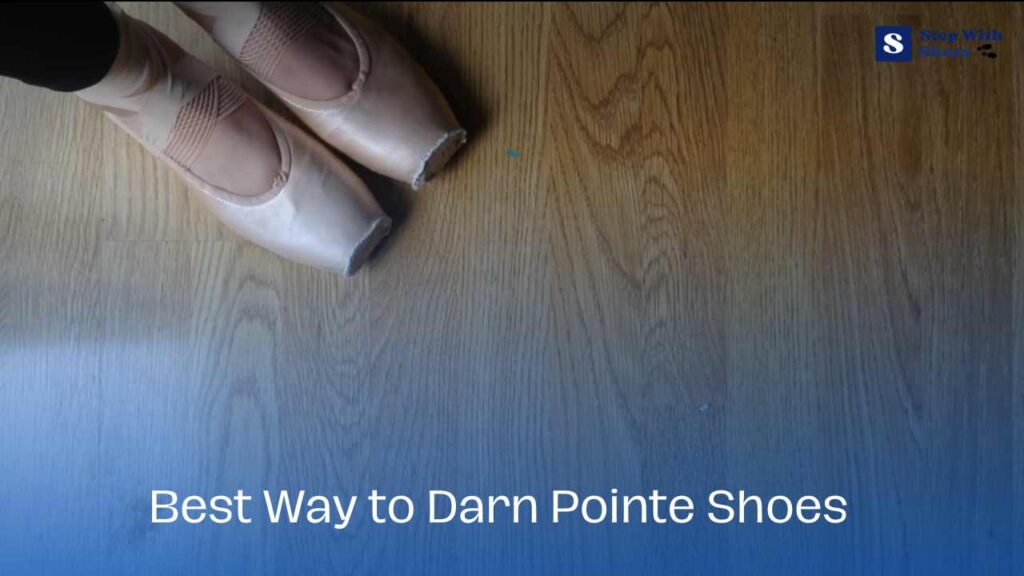
Darning pointe shoes is a delicate and crucial process to extend their lifespan and maintain their structural integrity. The best way to darn pointe shoes involves the following best practices:
1. Gather Your Materials: Before starting the darning process, ensure you have all the necessary materials ready, including darning thread, a darning needle, scissors, and a thimble if you prefer using one to protect your fingers. Using the right materials will ensure a clean and effective darn.
2. Prepare the Pointe Shoes: Begin by carefully inspecting your Pointe shoes. Clean and dry them thoroughly, removing any dirt, sweat, or residue that might affect the stitching. It’s essential to have a clean surface for the darn to adhere properly.
3. Choose the Right Thread: Select a strong, durable darning thread that matches the color of your pointe shoes’ satin. The thread should be of high quality to withstand the stress and tension it will endure during dancing.
4. Start with a Secure Knot: To begin the darning process, secure a knot at the starting point of your darn. This knot should be tight and close to the fabric, ensuring that your stitching remains in place.
5. Maintain Consistent Tension: One of the keys to effective darning is maintaining consistent tension in your stitches. Avoid pulling too tightly or leaving the stitches too loose, as this can impact the shoe’s support and flexibility.
6. Use the Right Stitch Pattern: The recommended stitch pattern for darning pointe shoes is the “satin stitch” or a similar close zigzag pattern. This type of stitch provides the necessary strength and stability for the shoe’s platform and shank.
7. Knot Securely at the End: When you finish the darn, secure it with a tight knot to ensure it won’t unravel during dancing. Trim any excess thread carefully.
8. Practice Patience: Darning pointe shoes can be a time-consuming process, but patience is key. Rushing through it can result in a less effective repair and possibly damage the shoe further.
You can ensure that your pointe shoes are darned effectively, providing the necessary support and durability required for your dance performances. If you’re new to darning, it’s recommended to practice on an old pair of pointe shoes or seek guidance from an experienced dancer or instructor to hone your darning skills.
How to Darn Pointe Shoes: Blanket Stitc?
Darning pointe shoes with a blanket stitch is a specific technique that provides both reinforcement and a neat finish to the damaged area. This method is ideal for repairing small holes or tears in the fabric. Here’s a step-by-step guide on how to use the blanket stitch for darning pointe shoes:
1. Gather Your Materials:
- Darning thread that matches the color of your pointe shoes’ satin.
- A darning needle with a large eye to accommodate the thread.
- Scissors to trim excess thread.
- A thimble or finger protector (optional) for added comfort during the stitching process.
2. Prepare the Shoes:
- Ensure your pointe shoes are clean and dry, free of any dirt or sweat. Proper preparation is essential for a successful repair.
3. Thread Your Needle:
- Cut a length of darning thread, typically around 18-24 inches, and thread it through the eye of your darning needle. Double up the thread to make it more durable.
4. Start the Blanket Stitch:
- Position your needle from the inside of the shoe to the outside, starting slightly to the side of the damaged area.
- Pull the thread through until you have a small tail inside the shoe.
- Insert the needle back through the fabric, making a diagonal stitch.
- Now, insert the needle through the loop you’ve created before pulling the thread taut. This forms the first half of your blanket stitch.
5. Continue the Stitch:
- Move slightly to the side and insert the needle from the outside to the inside of the shoe, creating another diagonal stitch.
- Insert the needle through the loop you’ve just made and pull it taut to complete the second half of the blanket stitch.
- Continue this process, creating a series of closely spaced blanket stitches to cover the damaged area. This will effectively reinforce and repair the fabric.
6. Finish Securely:
- To secure your work, tie a knot with the thread on the inside of the shoe and trim any excess thread.
The blanket stitch provides a neat, secure, and visually appealing repair for small damages in your pointe shoes. It’s essential to practice this technique to achieve the right tension and spacing between stitches for a clean and effective result. Remember that darning is a skill that improves with practice, so don’t be discouraged if your first attempt doesn’t look perfect.
Frequently Asked Questions Of How To Darn Pointe Shoes
How Do You Darn Pointe Shoes?
To darn pointe shoes, start by threading a needle with strong thread that matches the color of your shoes. Then, make small stitches along the worn-out areas, creating a patch. Keep stitching until the patch is secure. Finally, trim any excess thread and enjoy your newly repaired pointe shoes.
How Often Should You Darn Pointe Shoes?
You should darn pointe shoes when you start to see holes or wear in the toe area. It’s best to regularly check your shoes, and if you notice any signs of damage or weakening, it’s time to darn them. This will help prolong their lifespan and keep them comfortable and supportive for dancing.
Can You Darn Pointe Shoes Yourself?
Yes, you can darn pointe shoes yourself! Darning is a skill that many dancers learn to extend the life of their shoes. While it may take some practice to get it right, there are plenty of tutorials and resources available online to guide you through the process.
Plus, darning your own shoes can save you money in the long run.
Conclusion
To summarize, proper care and maintenance of your pointe shoes is essential to ensure their longevity and your comfort as a dancer. Darning your pointe shoes is a skill worth learning, as it can make a significant difference in the lifespan of your shoes and provide added support for your feet.
By following the step-by-step guide outlined in this blog post, you can easily master the art of darning and extend the lifespan of your pointe shoes. Remember to select the right materials, maintain good technique, and take your time to create strong and durable stitches.
Don’t forget to inspect and repair any damages to your shoes regularly. With proper care and maintenance, your pointe shoes can continue to support you through countless performances and training sessions. Happy darning!


